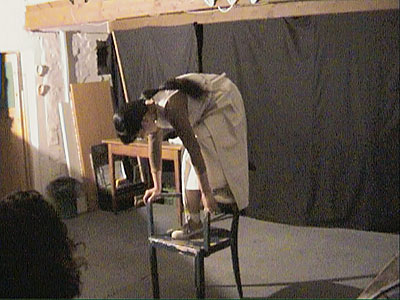| Zeitschrift Umělec 2003/3 >> THIS IS MY SOUND | Übersicht aller Ausgaben | ||||||||||||
|
|||||||||||||
THIS IS MY SOUNDZeitschrift Umělec 2003/301.03.2003 Martin Zet | neuigkeiten | en cs |
|||||||||||||
|
"There are words that sound as if they come from old legends. One is afraid to use them. To write them. To pronounce them. Nor is it very clear exactly what they mean today. But then, in an effort to find the term that expresses what you feel in the most precise way, express what you really want to describe, sometimes they just appear in your head. Earnestness, for example.
Earnest — does it mean expressing something without holding back, without ingredients, without other misleading, confusing, but also softening layers? Layers which could also make something entertaining out of the boring? But how much does it really matter how much you entertain? Did Polish writer Witold Gombrowicz ponder how much it was gonna be entertaining for readers when he wrote: “True realism, face to face with life, is the awareness that pain is the only definite, the only true reality”?* Earnestness, truthfulness, profundity. This quality has different degrees of popularity in art, depending on the field. Generally, it is not always the most valued. Its meaning is not lost in the frontiers of the documentary — in photography, video and some streams of literature; but it’s definitely not connected with a mere description of reality. It’s interesting that earnestness is an especially key element in the art of performance. Maybe this is thanks to the sometimes thin line between the performance as an independent branch (live art) and theater. Usually a performance is what is not acted. And even if there could be something like a script and it can also be repeated (re-run), it is still something different, specific. But why define? Performance is an instrument which, also because of its reluctance to be limited by definition, has found refuge in the world of contemporary visual arts, which is, after all, a little bit more open than other art fields. Sakiko Yamaoka was here for five days. At the end of September Japanese performer Sakiko Yamaoka visited the Czech Republic (Prague and Libušín). Thanks to a helpful program by the Center for Contemporary Art in Prague, and a happy constellation of events (the wedding of the English language editor of Umělec magazine) two of her performances were organized in Prague. The first was in fact two separate performances; the other — a fragile wedding embodiment of generosity — was a special repeat of her performance, now well known in Europe, called Dress (as far as I know: 2002 Transartcommunication, Nové Zámky, Slovakia; Maschinen Haus, Essen, Germany; 2003 — ZCCA-Libušín and its Left Lithuanian Wing in Bialystok, Gallery Arsenal, Bialystok, Poland). I want to speak about the first one (or the first part of her double performance) in the Center for Contemporary Art in Jelení, in the space called Kůlna (Shed), and how I found this experience linked to her text about pain, written for different performance called Garden. Garden It seems scientifically impossible to measure and express pain in the body. Doctors and scholars are still divided as to whether pain reacts from an affected part or originates in the brain. We have more or less known for some time that mental problems affect our bodies. But it is all the more difficult to explain such mechanisms objectively, particularly in the case of other people. When we deeply feel pain experienced by people close to us, is it because of the imagination or sympathy, or is it because we have one common “body”? On the other hand, is the understanding of the pain of people distant from us an issue for humanism? Interpretation that depends on the circumstances makes the nature of the senses incomprehsible. In the end, it is a question of consciousness and representation. I think that the question of pain is symbolized by artwork that revolves around the theme of the “body.” It is better for art that the more the nature is considered, the greater the extension of the interpretation and the possibility of representation, which will never be welcome in science. Yamaoka, Sakiko 03/2003 I don’t even know what this performance was called. Sakiko was sitting in a chair. She flicked herself in the head and she said: “This is my own sound.” And she went on: “When, if you hear this sound, it becomes your sound, too.” And then she demonstrated, identifying names, sharing and passing, cooperation, participation and what performance means to her and also the formal means (including the painful ones — to show how sound is related to weight, she allowed herself be thrown to the floor), which she was ready to apply, by using the metaphor of sound. Earnestly. Without distance. M.Z. in Libušín, Dec. 6, 2003 *Excerpt from the book Diary 1953–1956 (Polish original Dziennik) by Witold Gombrowicz (here translated from the Czech translation by Helena Stachová) (thank you, Miládka) "
01.03.2003
Empfohlene Artikel
|
|||||||||||||











Kommentar
Der Artikel ist bisher nicht kommentiert wordenNeuen Kommentar einfügen